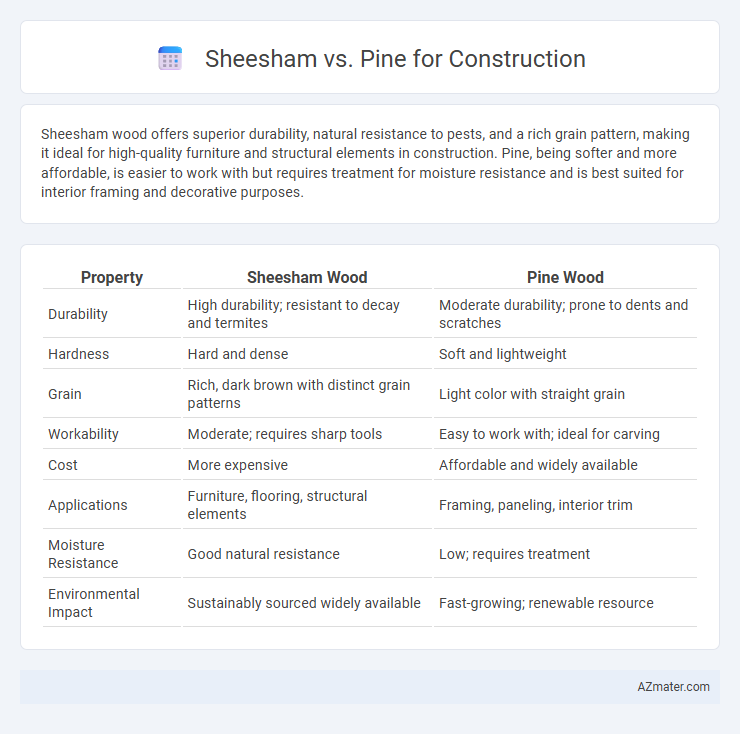Sheesham wood offers superior durability, natural resistance to pests, and a rich grain pattern, making it ideal for high-quality furniture and structural elements in construction. Pine, being softer and more affordable, is easier to work with but requires treatment for moisture resistance and is best suited for interior framing and decorative purposes.
Table of Comparison
| Property | Sheesham Wood | Pine Wood |
|---|---|---|
| Durability | High durability; resistant to decay and termites | Moderate durability; prone to dents and scratches |
| Hardness | Hard and dense | Soft and lightweight |
| Grain | Rich, dark brown with distinct grain patterns | Light color with straight grain |
| Workability | Moderate; requires sharp tools | Easy to work with; ideal for carving |
| Cost | More expensive | Affordable and widely available |
| Applications | Furniture, flooring, structural elements | Framing, paneling, interior trim |
| Moisture Resistance | Good natural resistance | Low; requires treatment |
| Environmental Impact | Sustainably sourced widely available | Fast-growing; renewable resource |
Introduction to Sheesham and Pine Wood
Sheesham wood, also known as Indian Rosewood, is a dense hardwood prized for its durability, natural resistance to decay, and rich grain patterns, making it ideal for high-quality furniture and construction. Pine wood, sourced from various species of conifers, is a softer, lightweight material valued for its affordability, ease of workability, and versatility in structural applications. Both woods offer distinct benefits in construction, with Sheesham providing long-lasting strength and aesthetic appeal, while Pine supports cost-effective and flexible building solutions.
Physical Properties Comparison
Sheesham wood, also known as Indian Rosewood, is denser and harder than Pine, offering higher durability and resistance to wear, making it ideal for heavy-duty construction. Pine is lighter with a lower density, providing easier workability and faster drying times but less strength and susceptibility to dents and scratches. Sheesham's natural oils contribute to its resistance against moisture and decay, whereas Pine requires treatment to enhance its weather resistance and longevity in structural applications.
Durability and Strength Differences
Sheesham wood exhibits higher durability and strength compared to pine, making it ideal for heavy construction and furniture requiring long-lasting performance. Pine is softer and less dense, leading to lower resistance against wear, dents, and environmental factors. The natural oils in Sheesham also enhance its resistance to termites and moisture, offering superior longevity in structural applications.
Resistance to Termites and Decay
Sheesham wood exhibits superior resistance to termites and decay due to its dense fiber composition and natural oils, making it ideal for long-lasting construction in humid environments. In contrast, pine is more susceptible to termite infestations and fungal attacks unless treated with chemical preservatives. The durability of Sheesham ensures structural integrity in comparison to pine, which requires regular maintenance to withstand biological threats.
Workability and Ease of Use
Sheesham wood offers superior workability due to its fine grain and moderate hardness, making it easier to cut, carve, and finish for intricate construction details. Pine, being a softwood, is generally easier to shape and nail, which speeds up installation but may require more careful handling to avoid dents and splits. Both woods provide ease of use in construction projects, but Sheesham's durability and resistance to wear make it a preferred choice for long-lasting, detailed work.
Aesthetic Appeal and Grain Patterns
Sheesham wood offers rich, dark hues with intricate grain patterns that enhance the aesthetic appeal of high-end construction projects. In contrast, Pine features a lighter color palette and more uniform, straight grain, providing a clean, rustic charm ideal for casual or country-style designs. The choice between Sheesham and Pine depends on the desired visual impact, with Sheesham delivering luxury and depth, while Pine offers simplicity and warmth.
Cost and Availability
Sheesham wood, known for its durability and rich grain, tends to be more expensive and less readily available compared to pine, which is widely accessible and budget-friendly. Pine offers a lightweight and softwood option, making it cost-effective for large-scale construction projects, while Sheesham's premium quality suits high-end furniture and structural elements where longevity is prioritized. Availability of Sheesham can vary regionally, often requiring importation, whereas pine is commonly sourced from local plantations, reducing lead times and transportation costs.
Environmental Impact and Sustainability
Sheesham wood, also known as Indian Rosewood, is a dense hardwood prized for its durability and resistance to pests, often sourced from sustainably managed forests, making it environmentally favorable compared to Pine, which is a faster-growing softwood but may come from less regulated plantations leading to deforestation concerns. Sheesham's natural oil content reduces the need for chemical treatments, enhancing its sustainability profile, while Pine requires treatments that can contribute to environmental pollution. Pine's rapid growth allows for quicker replenishment, yet the overall carbon footprint of Sheesham tends to be lower due to longevity and reduced maintenance requirements in construction.
Best Applications in Construction
Sheesham wood, known for its durability and natural resistance to termites, is ideal for high-quality furniture, flooring, and decorative paneling in construction projects requiring long-lasting and aesthetically rich materials. Pine, being lightweight and easy to work with, suits framing, molding, and temporary structures where cost-effectiveness and quick installation are priorities. Choosing Sheesham enhances structural elegance and longevity, while Pine offers flexibility and economic advantages in large-scale construction applications.
Final Verdict: Sheesham or Pine for Your Project
Sheesham wood offers superior durability, natural resistance to pests, and a rich grain pattern ideal for high-end furniture and long-lasting construction projects. Pine is a cost-effective, lightweight option with easier workability and a lighter color, but it is less resistant to wear and environmental factors. For projects demanding strength and longevity, Sheesham is the preferred choice, while Pine suits budget-friendly builds and decorative applications.

Infographic: Sheesham vs Pine for Construction
 azmater.com
azmater.com